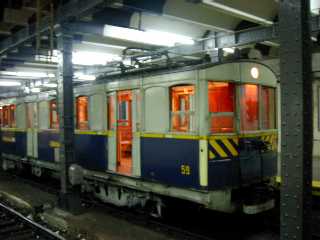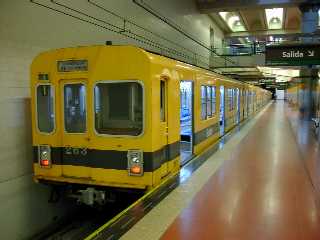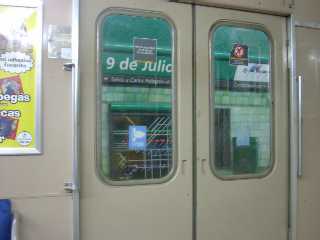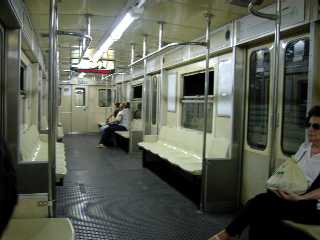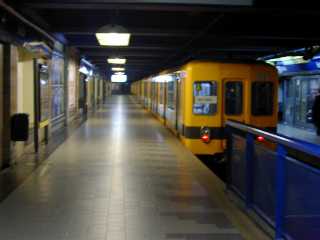 |
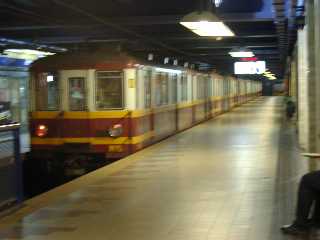 |
| Type 300, Higashiyama line's old car Enlarge | Original cars of Buenos Aires subway Enlarge |
Line C's trains are 6-coach. There are both cars from Higashiyama line and original cars, and it seems that the number of both is about to equal. The length of the car is: Higashiyama line's is 15.6m, the original car is 17m. The former has 3 doors on one side and the latter has 4. The 2 photos above were taken at Retiro station, the terminal of 3 suburban railways and long-way buses. Both of C line's terminals have 2 tracks and each trak has platfoams on both side. The platform between the tracks is boarding only and other platforms are arrival only and there are no gates on the arrival platforms so I could see the trains well from the entrance of the platforms.
These photos are out of focus and a fence is on the train, but it was difficult for me to catch all cars without catching the fence.
Original cars had been painted blown, like the right photo, but most of the cars were re-painted into yellow. I think they were made the same colour to Higashiyama line's. There is a direction sign board in front of the train and it seems this is functioning.
Among the subway in Buenos Aires, only trains of line B collect electricity from the third rail. Other lines have aerial electric wires. So Higashiyama line's cars are put pantographs newly. However, most of suburban railways are third rail system. And it is fearful that they have crossings.
It seemed that cars were commonly used between lines C, D and E. Maybe it caused that, I met sometimes trains on line C but the cars had line D's map.
 |
 |
| Re-painted original cars Enlarge | Type 300 Enlarge |
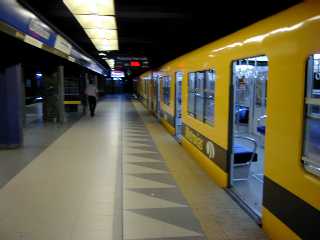 |
| Side of type 300 Enlarge |
These are at Constitución station, the other terminal of line C. Line C's and the suburban railway's stations were very dark and looked like NY subway's. Now they are under construction and will be bright.
The left above is the original cars of yellow. The right is the same car to the prior photo but this is another side. The left is side of type 300. The red light above the platform is a sign that shows left time to the departure in seconds. I found this sign at both of line C's terminals. Maybe some of other stations have it.
You can hardly find it in this photo but there is a station name sign at the top end of columns. It is parallel to rails and continues from end to end of the platform. Thanks to this sign, I felt stations are beautiful even no other things had been redecorated. I think this sign was installed when Marunouchi line's cars came and it was setted that line B's colour is red. You can see this sign often at stations in downtown. The white-back sign is a route map, but it doesn't show where here is so I could hardly find where I am.
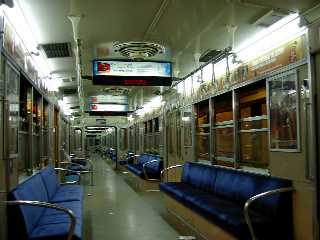 |
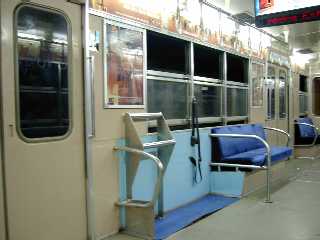 |
| Inside of Nagoya's car Enlarge | A space for wheelchairs Enlarge |
 |
| The end of a car Enlarge |
These are photos taken in Nagoya's car. The information display shows the time when I took this. Japanese trains rarely have clocks so this is better than Japan. It shows next station's information as `Próxima Estación XXX' and when the train is at a station, it shows `Ud. esta Estación XXX'. It is flashy display.
The right photo is a space for wheelchairs made newly. I wonder why mat is put. Most of trains in Japan don't have a belt to fix a wheelchair, does this mean trains here shakes harder than in Japan? Actually, Japanese trains' spaces for wheelchair is used for increase capacity so they don't recognize seriously the role it was expected, I think.
The left is the end of a middle car. The hood between cars was removed and a door was attached and rocked so passing is prohibited. Marunouchi line's cars are still original so we can pass through from 1st to 6th cars. Some Higashiyama line's cars are also keep their original so we can pass through between 1st and 3rd, 4th and 6th. Besides, you can see 'fire extinguisher' sign in Japanese. Of course, there is also a sign in spanish.
I forgot to take photos in old cars. There are 2 groups of seats setted face to face at one side between doors and the seat next to the door is for 1 person. when somebody seats here, (s)he almost seats with his or her back to the wall. A conductor is in a passenger cabin. He opens doors before the train stops so I was scared a little.
